Andy Warhol, Diane di Prima, Freddy Herko, The New York Poets Theatre and the Judson Dance Theatre
by Gary Comenas (2009/rev. 2015)

Diane di Prima with Leroi Jones at the Cedar Street Tavern, April 5, 1960 after a party at the Living Theatre
(Photo: Fred W. McDarrah)
The New York Poets Theatre (not to be confused with the Judson Poets Theatre) was founded in the spring of 1961. One of the founders, the poet Diane di Prima, later recalled that she and the other founding members of the company went to a notary's office in the spring to "complete the first steps in the process of founding the New York Poets Theatre." Di Prima had previously worked at The Living Theatre. She recalled that "the summer [c. 1960] was very full: I worked at the Living Theatre for Jimmy Waring and had my first staged reading of a play there: Murder Cake which I wrote one afternoon, part random exercise, part free association." (DP239)
Although many of the written accounts of the group indicate that the dancer and Warhol star Freddy Herko was a founding member of the New York Poets Theatre, di Prima indicates otherwise in her comments.
Diane di Prima:
"So it was that on a bright and gusty spring day, I walked with James Waring, John Herbert McDowell, LeRoi Jones, and Alan Marlowe to a notary's office, to complete the first steps in the process of founding the New York Poets Theatre. We were, the five of us, the founding members, and looking back I find it significant that Freddie [Herko] wasn't there... Plan was, we were going to make a theatre happen. One in which John's music, Jimmy's choreography and plays, Freddie's dances, my own and LeRoi's plays, all would have a place. A theatre where Alan would direct and manage the fund-raising (he had been a gay hustler in Europe, and demimonde/society personality in New York, and seemed to know some of the ropes.)
... Freddie's not being there, though, was telling. I think that for Alan, who carried the same blind prejudices as most 'straight' men, Freddie, by the mere fact of being his lover, was more or less negligible... What seemed a slight omission then (Alan suggested that five board members was good, because it was an uneven number, and wouldn't lead to a 'tie' vote) becomes enormous from my present perspective. Freddie would continue to have no real place inside the Poets Theatre. Though he worked with us continuously until his death in 1964." (DP255-6)
Alan Marlowe, whom di Prima describes as having been "a gay hustler in Europe" was actually married to di Prima from 1962 to 1969 (DQ) Warhol filmed di Prima and Marlowe in early 1964. Marlowe had also been the lover of Freddy Herko.
New York Poets Theatre
From October 1961 to February 1962, di Prima's New York Poets Theatre group presented plays at the Off Bowery Theatre (sometimes referred to as the Off Bowery "Gallery") at 84 E. 10th Street while, at the same time, exhibiting work by Ray Johnson and Jack Smith. (JD31) Two triple bills were presented at the Off Bowery, including, on the inaugural bill, LeRoi Jones' The Eighth Ditch which was taken from a larger work by Jones titled The System of Dante's Hell. The second bill of plays included work by James Waring, John Wieners and Robert Duncan. (SB63)
In March 1962 di Prima's group organized a "Poets Festival" at the Maidman Playhouse on 42nd Street, which included music by La Monte Young, Philip Corner, Richard Maxfield and Joseph Byrd; films by Stan Vanderbeek and Nicola Cernovich; Happenings by Allan Kaprow, Robert Whitman, George Brecht and Ray Johnson; and dance concerts which Freddy Herko participated in - but no plays. (JD31)
Several years later, in early 1964, the Poets Theatre re-grouped at a venue they called the New Bowery Theatre at 4 St. Mark's Place, and performed under the name of American Theatre for Poets (although di Prima refers to the group as the "American Arts Project" in her autobiography). (SB62/DP381) Freddy Herko was listed as one of the board of directors of that group in their prospectus which lists the directors as Alan Marlowe, Diane di Prima, James Waring, Fred Herko, LeRoi Jones, and Nicola Cernovich. (JD220n132) Three of the directors, Alan Marlowe, Diane di Prima and Freddy Herko, were also filmed by Warhol the same year - Alan Marlowe/Diane di Prima in about January 1964 and Freddy Herko for a Screen Test prior to his death in October 1964. (AD)
Flaming Creatures/Un Chant d'Amour/Andy Warhol Films Jack Smith Filming Normal Love
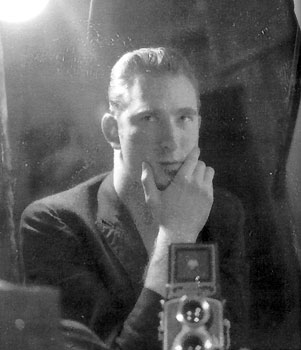
Jack Smith - Self-Portrait c. 1960
Jonas Mekas also operated his Cinematheque from the same venue that di Prima's group was using during the same period in 1964. Di Prima recalled one evening when the police busted the venue when Mekas showed Genet's film, Un Chant d'Amour (1950).
Diane di Prima:
"Checking the old flyers and programs, I see that all this happened in a shorter time than I imagined. No more than two months and the New Bowery Theatre was lost to us, a sign on the locked door saying 'This Poets' Theatre Closed By Order of Police.'
How we got there is more complex, but suffice it to say that our landlady proved to be a nervous type who was steadily and unswervingly suspicious of the avant-garde... it does seem likely that she was the force behind the police showing up at the theatre one Monday night just as Jonas Mekas' crew was setting up. The film that night was to be Chant d'amour by Jean Genet...
I was there taking tickets when the police arrived. I had seen the film before, and had been looking forward to seeing it again, but this turned out to be the wrong night for it. The police were befuddled. They knew they had to take somebody in, but it wasn't quite clear who: I was the only one there who was actually involved with renting the theatre, Jonas had no clear arrangement with us. (He gave us some money on the nights he actually broke even.) However it was Cinematheque's program and they owned the film.
It was too good an opportunity to miss, and Jonas and I further confused the police by each insisting that he/she be arrested instead of the other, in a fine contest of Sicilian vs. East-European bravado. They finally decided to arrest Jonas and cite the Poets Theatre.
The bust gave our landlady just the leverage she needed to close us down, and she did it immediately. When we went to the theatre the next morning, we found a padlock on the door, and painted unprofessionally on the lintel above was a sign: THIS POETS' THEATRE CLOSED BY ORDER OF POLICE." (DP378-9)
Prior to that bust, the venue had been busted for showing Jack Smith's Flaming Creatures. See here.
According to POPism: The Warhol Sixties by Andy Warhol and Pat Hackett, it was at that screening of Flaming Creatures that Warhol's footage of Jack Smith filming Normal Love was also shown and confiscated.
From POPism: The Warhol Sixties by Andy Warhol and Pat Hackett:
"The first movie of mine that was seized was a two-minute-forty-five-second one-reeler that I'd shot out in Old Lyme of everybody during the filming of Jack Smith's Normal Love... Actually, it was seized by mistake - what the police were out to get was Jack's Flaming Creatures.
Jonas's Coop had moved from the Gramercy Arts Theatre to the building Diane di Prima and some of the other poets used on St. Mark's Place on the southeast corner of the Bowery. After Flaming Creatures was seized, the screening there stopped for a little while. Then Jonas rented the Writers Stage on 4th Street between Second Avenue and the Bowery and he screened Genet's Un Chant d'amour there." (POP79)
Here is what Jonas Mekas said about the Flaming Creatures bust:
Jonas Mekas:
"...I made arrangements to screen it [Flaming Creatures] on 8th at the St Mark’s Theatre. To get in, I also put on the program a little film by Andy Warhol – just one roll of film – about Jack Smith making Normal Love [1963] and also something by the Kuchars. Ken Jacobs was the manager, Florence the ticket-taker and Jerry Sims was helping out. We were all arrested and the film seized. We spent one or two days in gaol. We were bailed thanks to Jerome Hill, who put up the money and paid all the expenses for the lawyers.. Then without telling anybody Jerome decided to complicate the case and let us get arrested one more time. That’s when I said I would screen Jean Genet’s Un Chant d’amour [1950] and Flaming Creatures again. This was at the Writers’ Stage on 4th St. In the audience was a policeman and I knew we would be arrested. But I was prepared: I had a chicken sandwich in my pocket."
We were arrested and the films seized. Again we were bailed by Jerome Hill. The court procedures took place and we had witnesses in our support – Susan Sontag, Allan Ginsberg – and we lost. We were sentenced to six months of suspended sentence. Emile Zola did his job in that at least we got only a suspended sentence." (See here.)
Film journalist and writer, J. Hoberman, gave the following account of the police raid in his essay "The Big Heat: Making and UnMaking Flaming Creatures" published in Flaming Creature: Jack Smith, His Amazing Life and Times.
J. Hoberman [from Flaming Creature: Jack Smith, His Amazing Life and Times]:
"On February 3, Flaming Creatures was shown with Normal Love rushes at the Gramercy Arts. Two weeks later, the theatre was shut down. The next screenings were at the New Bowery Theatre at 4 St. Marks Place where, on February 20, Smith had projected Normal Love production slides to the accompaniment of a taped radio speech by Antonin Artaud. Flaming Creatures was shown, together with Warhol's newsreel Jack Smith Filming Normal Love, on Monday, March 2, with an undercover policeman in the audience. The following night two NYPD detectives broke up a near-capacity showing attended by some ninety spectators. 'It was hot enough to burn up the screen,' one cop would tell the press. The police impounded both films, the projector and the the screen, arresting Mekas, the theatre manager, Jacobs, the projectionist and ticket-taker Florence Karpf." (JS162)
Andy Warhol films Alan Marlowe and Diane di Prima
It is not known when Warhol met di Prima but he certainly knew her prior to the screening. Earlier in the year he had filmed her with Alan Marlowe, as mentioned above. The footage is described in Andy Warhol, Poetry, and Gossip in the 1960s by Reva Wolf. According to Wolf "Warhol filmed the short episode-like movie of di Prima and Marlowe... soon after 29 January 1964 when di Prima sent a letter to the artist that alluded to his interest in making a film of the couple: 'come see us & shoot a Day in Our House like you said & show the Alan & me pornography -.'"
Reva Wolf [from Andy Warhol, Poetry, and Gossip in the 1960s:
"Warhol ended up filming di Prima and Marlowe for around three minutes, the duration of a 100-foot reel of film, rather than for the originally planned length of one day. Di Prima recalled, 'He came and shot a movie. It was a very short movie. A three or five minute movie of me and Alan. Alan is in bed, and he's covered by a tiger skin, which he's stroking the tail of in a very obviously suggestive manner. I get on the bed in a black leotard and tights and kind of trample him. It was a tiny room.'" (RW44)
Callie Angell refers to the footage in the first volume of the Andy Warhol film catalogue raisonné, noting that "As further information became available, it became apparent that Alan Marlowe/Diane di Prima (MoMA Screen Test Reel 13, no. 8) was not a Screen Test but a separate short film from 1964." (AD292)
Freddy Herko

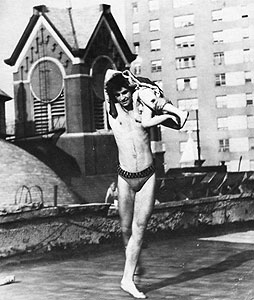
Freddy Herko dancing on a rooftop
(Photos: George Herms)
Warhol is also linked to di Prima through the dancer Freddy Herko who appeared in several Warhol films including two versions of Haircut, Rollerskate (or Dance Movie), Jill and Freddy Dancing, Kiss and a Screen Test. Herko also performed in quite a few productions at both the Judson Church and the New York Poets Theatre. For instance, when the New York Poets Theatre organized the Poets Festival at the Maidman Playhouse (on 42nd Street) in March 1962, Herko performed in two dance pieces. The first dance concert of the festival, on March 5th, featured a work by Herko and several works by Yvonne Rainer.
From Democracy's Body: Judson Dance Theatre, 1962-1964 by Sally Banes:
"The first of the dance concerts, on 5 March, featured the works of Yvonne Rainer and Fred Herko. Rainer danced The Bells, Three Satie Spoons, and Three Seascapes... She and Trisha Brown danced in Rainer's Satie for Two. Rainer also did a collaborative duet with Dariusz Hochman, called Grass and dedicated to the Great Wallendas. Herko presented Edge, a long group work for actors and dancers." (JD31)
On March 13th, another evening of dance was presented which included work by Herko as well as James Waring, Aileen Passloff, Ruth Emerson, Yvonne Rainer, and Trisha Brown. (JD32) Links to other productions that Herko participated in can be found on his main page at here.
Andy Warhol and Dance
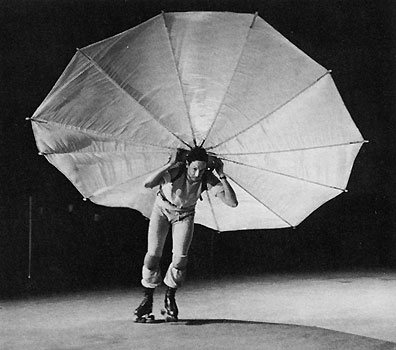
Robert Rauschenberg skating his way through the dance piece, Pelican, performed in conjunction with The Popular Image exhibition
(Photo: Peter Moore)
Warhol's interest in Herko reflects more than his interest in "beautiful boys." (When Herko's Screen Test was shown at the New Yorker Theatre on December 7, 1964, it was billed as an excerpt from The Thirteen Most Beautiful Boys. (AD93)) It also reflects Warhol's interest in dance. Warhol's film Dance Movie (or Rollerskate) (filmed c. late September 1963) featuring Herko on roller skates, was presumably influenced by Herko dancing at the Judson Church earlier in the year, in June 1963, with one foot encased in a roller skate. Robert Rauschenberg had also participated in a Judson Dance Theatre production on roller skates at a performance in Washington, D.C. on May 9, 1963, in conjunction with "The Popular Image" - an exhibition which included works by Warhol.
Allen Hughes reviewed Herko's Judson Church dance piece in the June 26th issue of The New York Times.
Allen Hughes [The New York Times, June 26, 1963]:
"An imperious whirring sound arose and through the curtain Fred Herko flashed in, looking beatific. He wore black tights, a yellow-and-blue jersey with "Judson" emblazoned across the front, and, on one foot, a black shoe and his means of locomotion - a roller skate. His other foot was bare.
Continuing to look beatific, he skated around the floor for a time, moving his arms and the unencumbered foot through various balletic positions. Before vanishing behind the white curtain, he did a bit of toe-dancing - roller skate and bare foot notwithstanding." (JD136)
Warhol's interest in dance is also reflected in other dance related movies he made. In addition to his Herko films, Warhol also filmed the dancer Lucinda Childs, dancer Paul Swan, choreographer James Waring and the dance reviewer Jill Johnston. Warhol had been a member of Carnegie Tech's Modern Dance Club in college and one of his non-Pop exhibitions in the early 1950s in New York consisted of drawings of the dancer Frank Butler, exhibited at the Loft Gallery in 1954. His Dance Diagram paintings (based on illustrations from two dance manuals published by the Dance Guild in 1956 - Lindy Made Easy (with Charleston) and Fox Trot Made Easy) were first exhibited at the Stable Gallery in New York in 1962. (AWM27) He had also lived in a large room rented from the dancer Franziska Boas less than a year after his arrival in New York.
(See here.)
John Cage
Warhol's interest in dance might also provide a link to John Cage although Warhol always denied that his use of repetitive imagery was linked to Cage's theories of musical seriality. When Warhol was asked by Benjamin H.D. Buchloh in 1985 whether his repetitive imagery had to do with "John Cage and concepts of musical seriality" Warhol responded that although he had met Cage when he was fifteen "or something like that" he "didn't know he [Cage] did serial things" and that he (Warhol) "didn't know about music." (KG324) (See Andy Warhol meets John Cage.)
Warhol would have heard Cage's music at Judson Church productions in the early sixties. In Popism, Warhol (via Pat Hackett) "guesses" that the first Judson Church "Happening" he attended was a performance by Yvonne Rainer.
From POPism: The Warhol Sixties by Andy Warhol and Pat Hackett:
"I guess I went down to my first Judson Church 'happening' because of [Robert] Rauschenberg - he was arranging the lighting there and I wanted to see it. I called up David Bourdon and told him to come with me to this beautiful concert there by Yvonne Rainer called Terrain, and later David said it was the most modern dance thing he'd ever been to." (POP51)
The dance performance referred to took place on April 28 & 29, 1963. (RO220) In the solo section of the event Rainer danced a dance called "Sleep." (JD115) About a month later Warhol asked his then-boyfriend John Giorno if he could film him sleeping. Sleep became Warhol's first full-length film.
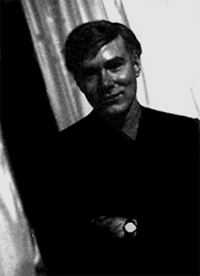
A portrait of Andy Warhol described
as "probably at the Judson Church" in 1963.
(Photo credit: Billy Name)
Although Rainer's piece did not use music by John Cage, it is likely that Warhol was at least aware of earlier dance events at the Judson which did feature Cage's music. The very first Concert of Dance included music by Cage accompanying a dance by future Warhol star Freddy Herko. A review of Herko's performance appeared in The New York Times in July 1962.
Other Warholian connections to the church included Billy Name doing the lights for the third and fourth Concerts of Dance there in January 1963. In the third concert, Freddy Herko performed "Little Gym Dance before the Wall for Dorothy." "Dorothy" was Dorothy Podber, the woman who would later shoot a hole through some of Warhol's Marilyns with a pistol.
In September 1963 Warhol also designed the stage layout for one of the other groups at the church - the Judson Poets Theatre production of Asphodel, In Hell's Despite which was directed by SOAP OPERA co-director, JERRY BENJAMIN. (SB79) Warhol's scriptwriter, Ronald Tavel, also recalled attending a Judson event with Warhol.
Erik Satie
Erik Satie's music was also used for dance pieces at the Judson Church and the New York Poets Theatre. Some writers have suggested that Warhol's repetitive editing of Sleep was influenced by a performance of Satie's Vexations organized by John Cage at the Pocket Theatre (a venue also used by Herko and James Waring), that, it is claimed, Warhol attended in 1963. However, there is no actual evidence that Warhol attended the performance or that he had it in mind when he edited Sleep. See here.
Regardless of whether Warhol attended that particular concert, he would have been familiar with Satie's music through dance performances at the Judson or the New York Poets Theatre. Freddy Herko, for instance had used Satie's music for his dance piece Once or Twice a Week I Put on Sneakers to Go Uptown at the first Concert of Dance at the Judson Church which also featured Cartridge Music by John Cage in two other dances performed the same night by other dancers. (JD40/43)
The Death of Freddy Herko
Herko's career as a dancer unfortunately ended in 1964. His final dance performance took place on October 27, 1964 when he danced out of the window of Johnny Dodd's apartment. Dodd was a friend of Herko who did the lights at the Caffe Cino, the Theatre Genesis, and some of the productions at the Judson Church. (SB112/164) (Dodd, who was also a friend of Billy Name - as was Herko - was filmed by Warhol for Kiss and one of the Haircut films.) Herko's final dance - and a memorial ceremony after his death at Diane di Prima's apartment - is described in Popism.
From Popism by Andy Warhol and Pat Hackett:
"A few days later, on October 27, he [Herko] turned up at an apartment on Cornelia Street that belonged to Johnny Dodd, who did the lighting for the Judson Church concerts... What Freddy did when he got inside was go and take a bath... After his bath, Freddy put Mozart's Coronation Mass on the hi-fi. He said he had a new ballet to do and he needed to be alone. He herded the people there out of the room. As the record got to the 'Sanctus,' he danced out the open window with a leap so huge he was carried halfway down the block onto Cornelia Street five stories below.
For the twenty-six nights following Freddy's death, the group at Diane di Prima's apartment met formally to read the Tibetan Book of the Dead. The ritual involved making sacrifices, and most people pulled out a few of their hairs and burned them.
There was a memorial service for him at Judson Church, but so many people showed up that there was another one for him, at the Factory. We showed the three films." (POP85)
Herko had got increasing involved with drugs - the extent of his problem was noted by di Prima in her poem "FORMAL BIRTHDAY POEM: February 23, 1964" published after his death in FREDDIE POEMS:
dear Freddie, it's your birthday & you are crazy
really gone now, crazy like any other old queen
showing off your naked limbs a little withered
making fairy tales into not very good balletsI remember you sat on the edge of the bed & Joan cried
you sat wrapped in a blanket night after night by the fire
you sat by the fire & cried, you played the piano
you were truly lovely then, but a little fathow spoiled we all were! we ate hundreds of english muffins
and never thought once about white flour, or bread lines
or calories, or what vitamins we were getting
I guess old junkies just have to be more carefulyes, now you are 28, you are shooting A
you are getting evicted & there is another coldwave
you are worried about your costumes - can you take them
with you & to where? you are late a lot for performanceand not very good, although you are sure you are perfect.
yes, somebody said you thought you were martha graham
and it is a little like that. but blood is thicker
than water, & I am angrywhen I am angry, because you've disgraced the family
another old whore on the streets, another mouth
to feed in emergencies, and we think a lot
about keeping you away from jail & the madhouse
In addition to the Herko memorial at the Factory mentioned above in Popism, Warhol commemorated Herko's death by dedicating a Flowers painting to him. According to Callie Angell in in the first volume of the Warhol film catalogue raisonné, "After Herko's death, Warhol dedicated a white Flowers painting to his memory, which was included in his Flowers exhibition at the Leo Castelli Gallery in November 1964." (AD93)
After 1964, there was little, if any, contact between di Prima and Warhol. She is not mentioned in Warhol's diaries from the late 70s/80s. Theatre productions by di Prima's group were sporadic after 1964, as she focused more on her writing and poetry. Warhol's interest in dance and music continued. He presented the multimedia Exploding Plastic Inevitable beginning in April 1966 featuring The Velvet Underground accompanied by various Factoryites dancing onstage and in 1967 produced the Velvet's first album.
In 1968 Warhol's Silver Pillows were utilized by the dancer Merce Cunningham (John Cage's lover) for performances of Cunningham's dance piece RainForest which also featured costumes by Jasper Johns. (AWD405) Johns had originally asked Warhol to do the costumes.
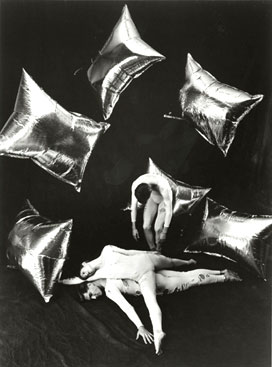
Merce Cunningham's RainForest featuring Andy Warhol's Silver Pillows
Jasper Johns:
"When I approached Warhol to say that Merce would like him to design the decor for RainForest, Andy said, 'Oh, just take a lot of those pillows.' And I said, 'What about costumes?' and he said, 'Oh, they shouldn't wear any clothes.' And I said, 'I don't think that idea would work with Merce,' and he said, 'Oh.' But he didn't suggest any other idea. And when the subject of the costumes came up with Merce, he brought this garment that I think he had been wearing when he practiced and tying knots in it as it got torn, and he said, 'I think something like this might be all right.' So I imitated the thing he had brought me, cutting into the garments and tying knots." (JJ237)
Warhol also did silkscreens of Cunningham as early as 1963 and later, in the 1970s, a series of screenprints of the dancer. In 1994 the Warhol museum documented Warhol's involvement in Cunningham's RainForest with "RainForest: A Documentary Exhibition" which ran September 1 - October 30, 1994.
In 1974 Warhol also produced a short-lived Broadway musical, Man on the Moon, in 1974, and did numerous pop promos in the 80s. This is in addition to the record covers he designed throughout his life. A catalogue raisonné of his album covers, Andy Warhol: The Record Covers 1949-1987, was published in November 2008. " Warhol Live," a traveling exhibition focusing on Warhol's involvement with music and dance toured in 2009.
Gary Comenas
Warholstars/2009/rev. 2015